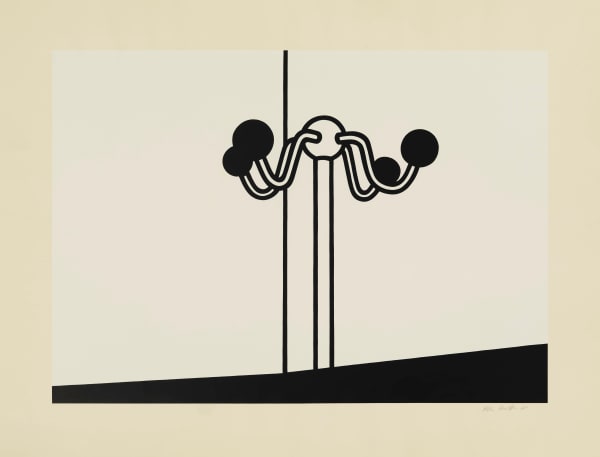Tracing Absence
Abandoned objects, rooms and buildings, empty roads and lonely horizons become ambiguous scenes, to which only a trace of life that came before or after is alluded. Depictions of interiors by Patrick Caulfield, Paul Winstanley, Hurvin Anderson and Paul Noble are pointedly devoid of people. In their works a sense of melancholy, or in the case of Noble, urgency, pervades the human story that is hinted at having unfolded.
In Paul Winstanley’s etchings of unpopulated art schools, the studios appear calm and serene with traces of the bustling creativity that is fostered there; paint stains, marked walls and worn furniture. Further prints depicting empty rooms occupied only by old light fittings and thinly veiled curtains, are starkly lit and rendered in muted colours, suggestive of a space abandoned by a previous occupant. Hurvin Anderson’s print of a barbershop located in a small attic has been stripped bare of people and tools.
Anderson, whose ongoing body of work explores the cultural significance of the barbershop to the Caribbean diasporic community in the UK, has reduced the walls and furniture to near abstraction. However, the clock and mirror remain, indicating the human life that existed there before. Etchings and drawings by Paul Noble depict sections of wallpapered rooms. All other signifiers of the space we are viewing, whether it be private or public, are absent. The rooms appear endless with no doors or windows.
In contrast Patrick Caulfield’s interiors focus on everyday objects and furnishings. What should be busy shared spaces, such as cafés and restaurants are devoid of people. His pared down interpretations of abandoned tables, empty glasses and coat hooks, which appear like props on a stage, create a sense of stillness and solitude. By isolating these objects Caulfield hints at human activity that has either just taken place or is about to.
Drawings by Marie Harnett also suspend a moment in time, but in her work human presence takes on a physical, ghostly dimension. We can trace the outlines of figures in the intimate settings of a party or bedroom. Harnett captures film stills which she overlays to make highly detailed drawings. A sense of unease pervades the drawings, as the perspective suggests we are intruding on the scene.
Stepping outside, works by Christiane Baumgartner, Emma Stibbon and Clare Woods present vast landscapes and horizons that have been shaped and marked by human activity.
Emma Stibbon’s drawings and prints explore the impact of human activity on our planet through depictions of melting glaciers, rising desert temperatures and shifting tectonic plates. People never appear in Stibbon’s work, but their presence is implied within the frame. For example, an abandoned shed reminds us of the inhabitants once present. In larger works, Stibbon uses scale to pull the viewer into the image, suggesting a sense of being there, a witness to the threatening or catastrophic event.
The role of the viewer as witness to a pause before or after an event of human destruction is also present in new screenprints by Clare Woods. Her pink and orange clouds are based on images of background skies from Ukrainian news reports. We cannot determine this from looking at them, however when we know, it changes our understanding of the images. The scenes become loaded with danger, but no trace of man’s aeriel threat is observed.
Christiane Baumgartner’s early works explore spartan urban surroundings and representations of speed. Footage of white smoke contrails from planes, road tunnels, vast stretches of asphalt and landscapes glimpsed from fast moving cars are captured by Baumgartner and transferred to woodcut, where she takes a moving image and stills it. However, these familiar everyday scenes, frozen in time, become vacant and impersonal through the absence of a human presence.
For sales enquiries or further information please contact [email protected]
6 – 7.30pm, Thursday 9 May 2024
Join us for the private view of Tracing Absence. This late opening, with refreshments, also includes an opportunity to view Vicken Parsons: Time. Confirm your attendance via [email protected].











